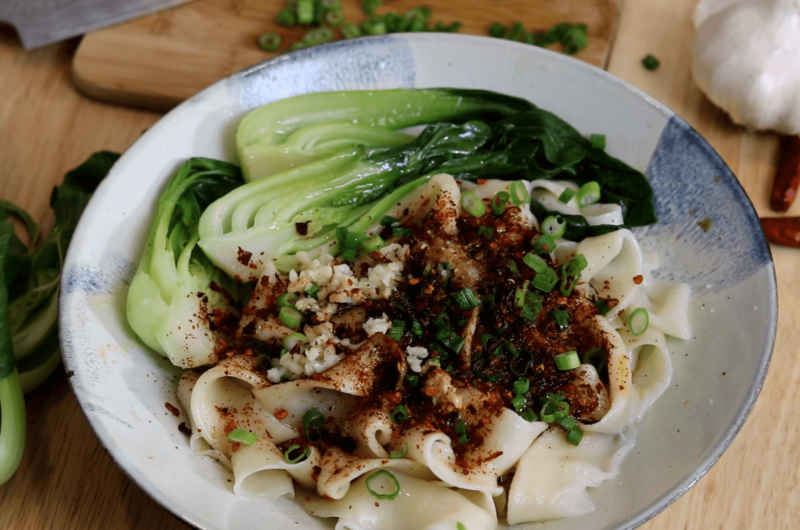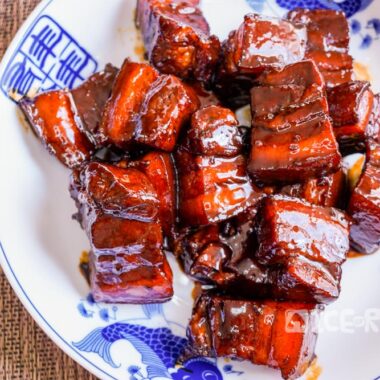Biangbiang noodles, also known as belt noodles due to their broadness and length, are a specialty of Shaanxi province in China. The noodles are usually topped with vegetables and herbs such as spring onions, garlic, leeks, coriander, Sichuan peppercorns, cumin, and chili.
There are two stories about the origin of these unusual noodles: one says that the name stems from the sound of handmade noodles being stretched and flapped, and the other one says that the word biangbiang was invented by a Chinese Emperor. Unusually, the word biang doesn’t exist in the Chinese language, and it is made up of 57 strokes, the most of any Chinese character.
Chinese Bian Biang Noodles (油泼扯面 – Yóu Pō Chě Miàn)
Course: MainCuisine: ChineseDifficulty: Difficult1
servings2
hours20
minutes300
kcal2
hours20
minutesBiangbiang noodles, also known as belt noodles due to their broadness and length, are a specialty of Shaanxi province in China. The noodles are usually topped with vegetables and herbs such as spring onions, garlic, leeks, coriander, Sichuan peppercorns, cumin, and chili.
Ingredients
- FOR THE NOODLE DOUGH
300 grams of high protein flour bread flour, dumpling or noodle flour
1/2 tsp of salt
150 grams of room temperature water
Enough cooking oil to coat the dough
- FOR 1 BOWL OF NOODLES
3 pieces of Biang Biang Noodles
A few pieces of Baby bok choy
1.5 tbsp of soy sauce
1.5 tbsp of Chinese black vinegar
2-3 tbsp of diced scallion
1-3 tsp of chili flake
2 cloves of garlic
Salt to taste
2-3 tbsp of cooking oil
Directions
- Add 1/2 tsp of salt to 150 grams of room temperature water. Stir to dissolve.
- Pour the salt solution into 300 grams of flour. In batches Stir it with a pair of chopsticks at the same time. Gathering the flour together and make it into a dough. Cover it and let it sit for 15 minutes.
- 15 minutes later, knead the dough for a few minutes or until smooth. Cover it. Let it sit for another 15 minutes.
- You can use a stander mixer to do this since it is a lot of work. We will repeat this kneading, resting process for 3 to 5 times. While we are kneading the dough, the glutens are stretching and bonding again and again. Eventually, all the proteins will form into a network and that gives the great texture for the noodles.
- Divide the dough into 6 pieces. Shape each piece into a round smooth ball. Cover them with a plastic film so they don’t get dry.
- Take one piece of the dough. Flatten it with your hands and then roll it into a thick oval sheet. Get a big plate. Drizzling some cooking oil. Coat the oval dough sheet both sides with the oil. And continue doing the next one.
- Set all the dough pieces on the plate. Cover them with the plastic film, gently push out all the air so the wrap can touch the dough directly. If you leave too much air in there, the dough will turn out with an uneven dried surface. Let this sit for 2 hours at room temperature. You can also let it chill in the fridge overnight but be sure to take it out 1 hour in advance so it can get back to the room temperature.
- hours later, take one piece of the dough. Get a chopstick. Press it in the middle. Use both of your hands to slowly and evenly pull it. Once you get it long enough, you can start hitting the working surface. This will lower the chance of breaking while you are pulling. If you see any part that is a little thicker, it is ok to re-pull that part. When it reaches the length that you like. Follow the chopstick mark and rip it open right through the middle. Give it a few more swings. And you just made 1 piece of Biang Biang noodle.
- The amount that I gave is enough to serve 2 people so 3 pieces of noodles are one serving. Add the noodles directly into the boiling water. Stir it a little bit. Cook it for a few minutes. Then throw in some baby bok choy, let it blanch for 20 seconds and you take everything out.
- In a big noodle bowl, add some soy sauce, some Chinese black vinegar, if you don’t have it, balsamic vinegar can be a substitution. Throw in the cooked noodles. Sprinkle some diced scallion, some red chili flake, as much as you like. Then press a couple of garlic. Some salt to taste. Heat up some cooking oil until smoking hot, pout it on to the spices and aromatics. Your whole kitchen will smell amazing at this moment. Mix it up and you are ready to enjoy!







2 Comments